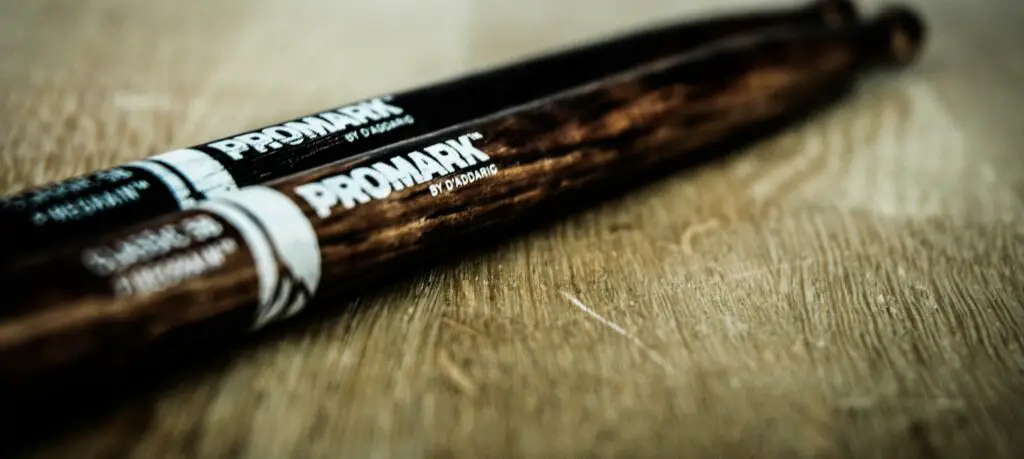Different size drumsticks sound and feel different, so it’s important to try and choose the ones which suit you the most. Two popular sizes are 5a and 7a; so in this article I’ll compare them directly so you know exactly which to choose.
5a vs 7a Drumsticks Overview
5a drumsticks are longer, thicker and heavier compared to 7a drumsticks. 5a drumsticks feel more powerful and are very versatile so suit most styles of music, whereas 7a drumsticks feel softer and are usually used for jazz music.
| 5a Drumsticks | 7a Drumsticks |
| 16” length | 15”-15.75” length |
| 0.565” diameter | 0.54” diameter |
| Average 40g | Average 37g |
| Sound louder and heavier | Sound quieter and softer |
| Very versatile, good for most styles of music | Good for jazz and softer styles of music |
| Feel powerful but less fast and nimble | Feel fast and nimble but not powerful |

Size and Shape
There are three differences between the dimensions of 5a and 7a drumsticks:
- 5a drumsticks are slightly longer than 7a drumsticks. 5a drumsticks are 16″ in length, whereas 7a drumsticks are between 15″ and 15.75″ (depending on brand)
- A 7a drumstick is thinner than a 5a drumstick. 7a drumsticks have a diameter of 0.54″ whereas 5a drumsticks have a diameter of 0.565″.
- Since 5a drumsticks are longer and thicker than 7a drumsticks, they are also heavier.

Sound Differences
A 5a drumstick is thicker and longer than a 7a drumstick, and hence has more mass. It’s actually the difference in weight that causes the drumsticks to sound slightly different from one another.
5a drumsticks will produce a louder sound with more low-end compared to a 7a drumstick. In other words, a 5a drumstick sounds fuller and heavier. The 7a drumsticks on the other hand sound thinner and softer.
There’s not a huge difference between the two but here’s a great quick YouTube video where you can hear the difference between 5a and 7a drumsticks.
What are 5a drumsticks good for?
5a drumsticks are very versatile and well-suited to most styles of music. For very soft styles of music such as jazz, they are not the preferred choice as they can sound a bit too heavy. For aggressive styles such as metal, 5a drumsticks may be a bit too light and a heavier stick such as a 5b or even a 2a.
What are 7a drumsticks good for?
7a sticks are not as versatile as 5a sticks and are generally only used for lighter styles of music such as jazz, they are also a popular choice in marching bands. 7a drumsticks can be used for other styles of music such as rock, but typically a heavier stick will be used to get more power and volume.
Differences in Playing Experience
Not only do 5a and 7a drumsticks sound different, but they also feel different.
- 5a drumsticks feel more powerful than 7a drumsticks
- 7a drumsticks feel quicker and more nimble than 5a drumsticks
Since 7a drumsticks are lighter, they also help you to play a bit faster and makes them more suitable for younger drummers. 5a drumsticks can also be used by younger players, but are better suited to teenagers and adults.
Some players prefer the thinner feel of 7a drumsticks and like them because they feel light and nimble, however others find them too thin and find 5a to be the perfect size.
It’s all down to personal preference so I’d recommend trying to get a hold of some sticks to test them out and see which you prefer the feel and sound of.
Which Sticks are Best for Beginners?
Both 5a and 7a drumsticks are good sizes for beginners. 7a drumsticks will suit jazz musicians and children more, whereas 5a drumsticks are good for beginners of all ages who are trying to play rock and other styles of music as they are a bit more versatile.
Which Sticks are Less Likely to Break?
7a drumsticks are slightly more likely to break compared to 5a drumsticks because they are thinner. However, 7a drumsticks are only about 4% thinner than 5a drumsticks so I wouldn’t really factor this into your decision.
Check out my comparison between 5a and 5b drumsticks.
